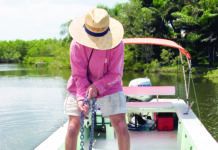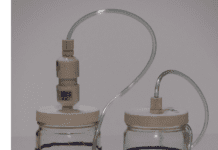Wind Generator Noise
Meeting all the design criteria for a sailboat wind generator does require some compromises.
With respect to your commentary on the noise of the Air Marine generator in the February 1, 1999 issue, and Andrew Kruses response in the May 1, 1999 issue in which he criticized our KISS generator, we have to say that noise is a very subjective measure. Different people will notice different noises. While we were cruising, we met people who thought their Air Marine generators were making no noise, although we could hear more noise than we would have wanted to live with. On our 36-foot boat, by necessity, we live very close to our KISS wind generator and prefer its swishing noise. The KISS wind generator is designed by, sold by, and built for cruising sailors.
We have never made any claim as to the KISS being the quietest generator, as Mr. Kruse of Southwest Windpower states. The 60″ diameter blades cover a large swept area in order to gather a lot of wind power, and the generator is designed to spin at a low RPM to minimize noise. The KISS is proud to be among the quietest while producing a great deal of power. Nor do we claim that the KISS is the best design for every application. In fact, we have recommended to some potential customers that they buy solar panels or a competitors generator if they have low energy needs and/or sail in areas with mostly very low wind speeds.
Any device with exposed spinning blades can be dangerous. Because of its light weight and strong blades, the KISS wind generator has never had a blade failure or caused personal injury due to overspeeding as Mr. Kruse implies. He also stated that Failures of most wind turbines are due to poorly designed products lacking any kind of safety overspeed control device. Didnt the Air Marine generator initially suffer from an unusually high failure rate despite having a safety overspeed control device? He inaccurately stated the KISS has no overspeed control device. The KISS wind generator has a safety overspeed device that allows the cruising sailor to switch the control to the off position in winds up to 35 knots, causing the blades to turn very slowly, similar to the switch on the Air Marine.
I can understand Mr. Kruses desire to divert attention from the issue of noise to the issue of safety. Is the noise it produces enough to keep someone from buying an AIR? We think so.
John Gambill and Libbie Ellis
Hotwire Enterprises
St. Petersburg, Florida
I saw a number of letters on wind vane noise and thought I would add my 3 dBs! I was in an anchorage a few weeks ago and could hear clearly the Air Marine in a nearby boat, but could not even hear my own Ampair on the mizzen. On the other hand, my Ampair seems to put out a max of only 2-3 amps! Why it was installed on a boat with a genset is beyond me!
The Fourwinds on the boat I am trying to sell had a fair bit of noise when it was first installed, about five years ago. But subsequently, Bill Aura of Everfair, the manufacturer, released a turbulator kit consisting of a thread to be superglued just behind the leading edge of the blades. This dramatically reduced the noise level.
Roger Bohl
via e-mail
A good deal of noise attributed to Air Marines wind generator comes from sailors, including some PS readers. Some claim quiet operation, others utter oaths. Could I offer a simple suggestion-no special washers or by-the-gram blade balancing-that I think will reduce noise from most of these units?
Older units blades were not finished smoothly. And the blade tips, which approach Mach 1 in a blow, could be unevenly shaped. Simply sand each blade lightly with 220-grit sandpaper until smooth, and in a similar manner adjust the blade tips so they are smooth and symmetrical. To be the quietest in ones marina or anchorage, end with a light coat of wax nicely buffed. The newer units have flattened blade tips that are more uniform and the blades are manufactured more smoothly, but they can still benefit from this treatment. Sometimes we expect a bit too much of things coming straight out of the box.
Jack Tyler
St. Petersburg, Florida
We have an Air Marine Air 403 wind generator from Southwest Windpower. It is attached to a mounting kit (tower) supplied by them. The tower consists of a 2″-diameter main pole, which is attached to the deck of the boat by a rubber bung that is compressed to spread it out by an internal bolt. This is attached to a deck fitting. The main pole is supported by two smaller poles, acting as guys. One leads forward along the gunwale, the other leads athwartships, across the transom. When the wind comes from the general direction of the guys, the main pole is in compression, and there is no problem. When the wind comes from the opposite direction, i.e., generally from astern, the main pole is in tension, and the rubber bung support is unreliable. A diagram of the mount appears on page 477 of the current West Marine catalogue, where the generator is also advertised.
During a storm at sea, we had wind from astern. The mount for the generator came out of its support, and it was only good luck that prevented the machine from decapitating the helmsman before we could shut it off (there is a shorting switch provided to shut off the generator), wrestle it into submission and lash it to the pushpit. The blades were destroyed in the ensuing argument with our backstay. The literature with the generator says the unit will withstand winds of up to 100 mph, so we were well within the range claimed.
Southwest Windpower is aware of the problem. I have spoken to them, and they seem to be good people to deal with. They have a new mount. I have no quarrel with them.
Other owners of this mounting system should be informed about the danger. It is relatively easy to re-design safely.
Emanuel Laufer
Halifax, Nova Scotia
Canada
Southwest Windpowers Andrew Kruse told us that after your accident the mount was redesigned. About 50 like yours were sold. Since the change, more than 500 have been sold, with no reported failures.
Seizing Anchor Shackles
Regarding the PS Advisor about the proper metal for seizing anchor shackles (February 15, 1999), I would like to add my two cents worth.
Instead of using any metal wire for this application, I have successfully used plastic electrical wire ties to seize my anchor shackle pins and have experienced no failures in more than 20 years. I thread the tie through the shackle pin hole and around the inside of the shackle and eventually through the wire tie locking head, then trim the excess to a smooth finish with wire cutters. An additional application is to use them in different colors or in groups in order to mark the length of an anchor chain. These ties are simple and quick to apply, are low cost and impervious to corrosion. I change mine every year or two for added safety.
Rafael G. Belliard
Baton Rouge, Louisiana
HOPA for Atomic 4
I read with great interest the very timely article in the April 15, 1999 issue on high-output alternators. You really hit the nail on the head regarding charging rates, battery needs, regulators and physical requirements for alternators. I want to make you aware that we offer a high output alternator upgrade kit specifically designed for the Atomic 4.
In getting to the point of defining the hardware for our kit, I evaluated a number of alternators and regulators. None of the alternators readily available offer spark arresting screens. Balmar explained that theirs were tested in accordance with a USCG specification which stipulated that the alternator had to be run under load in an explosive atmosphere without causing an explosion in order to be certified. It was certified under that specification. The Hehr Powerline alternators are not really recommended for application on gasoline engines in boats because they do not have screens nor have they performed the above referenced test. I finally found a source for what is essentially an AC Delco 105-amp alternator with screens, turbo fan, and no internal regulator. Output is 65 amps at 1,600 engine rpm (2,400 alternator rpm), which is a somewhat reasonable cruise rpm for a direct drive Atomic 4.
I only looked at smart regulators. After evaluating most of the ones mentioned in the article, I settled on the Aqualine for several reasons. First, it has more bells and whistles than any of them-three charging stages, adjustable set point for voltage level, adjustable current limit, gel cell protection, halogen light protection, battery temperature probe (optional), and a manually activated equalization cycle. More importantly for the Atomic 4 is the built-in soft start feature. For the first 90 seconds of engine operation, there is no alternator output. One-third output is applied after the 90 seconds, then two thirds after another 20 seconds and finally full load at the end of yet another 20 seconds. This delay sequence allows the drive belt to stretch its legs somewhat before load is applied and also allows the engine to warm up a bit.
The kit sells for $450 and is available by calling Indigo Electronics at 1-800-428-8569.
Tom Stevens,
Vice President Indigo Electronics
Newport News, Virginia
Solar Panel Diodes
I believe that there may be another reason for the parallel diodes in the Kyocera KC-60 panels aside from redundancy (see PS, April 15, 1999). Two diodes of equal forward resistance, when in parallel, will have half the forward resistance of one alone, resulting in greater effective output. And the diodes wouldnt have to be matched, either. But to figure that, youd have to employ the formula for parallel resistances.
Stuart James
via e-mail
New Glass
I think I can help answer two of the questions you raised in the review on fiberglass restorers (April 1, 1999), specifically flaking and yellowing.
I applied New Glass to our Taylor 38 three years ago because I didnt want the hassle (and potential danger) of waxing and power buffing the hull from a ladder. It started to flake the second year. The fault, however, was not with the product but with the person who applied it (me). I didnt degrease the hull thoroughly enough before applying it. After seeing the results on my boat, a friend did his boat one year later and has had no flaking problems because he used a commercial strength degreaser.
New Glass definitely does yellow a bit over time, because the gelcoat on our boat is whiter where the New Glass has recently flaked off. However, unless you want a hull that is as white as fresh snow, I don’t think this is a serious drawback.
Im so happy with the product that Ill be stripping it off, compounding the hull to remove some oxidation and reapplying it properly this fall. I estimate that the amount of time Ive saved over three years, compared to waxing and buffing, will more than offset the time spent stripping it off.
If you do it properly the first time, the results are impressive and the two to three maintenance coats required each year take far less time and effort than waxing and buffing. Ive found that the 32-ounce bottle of New Glass is good for seven to eight coats on my boat, which is much better than the estimate of a 25-foot boat from one bottle given in the review.
Bob Davie
via e-mail




































